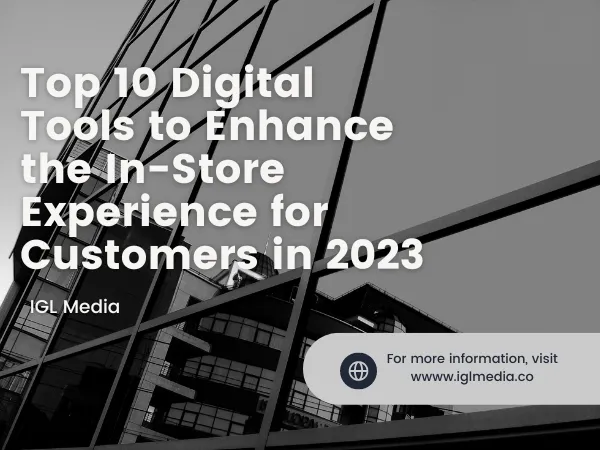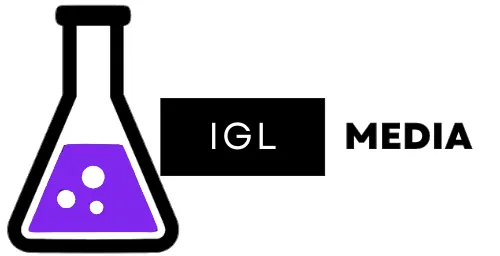
Top 10 Digital Tools to Enhance the In-Store Experience for Customers in 2023
“The best marketing doesn’t feel like marketing. .” - Tom Fishburne
Introduction:
The retail landscape has changed dramatically over the past decade, with the rise of online shopping and the increasing importance of digital tools in the shopping experience. However, brick-and-mortar stores remain a key part of the retail experience, and in many cases, can offer a level of engagement and personalization that online shopping cannot match. In this post, we'll explore how digital tools can enhance the in-store experience for customers, and help brick-and-mortar stores stay competitive in a rapidly changing retail landscape.

With that said, here are some digital tools to improve your customer's instore experience!

1.Personalized Recommendations and Promotions
One of the biggest advantages of digital tools is the ability to offer personalized recommendations and promotions to customers. By using data from past purchases, browsing behavior, and customer preferences, stores can offer targeted recommendations and promotions to customers while they are shopping in-store. This can help customers discover new products, and also increase the likelihood of a purchase.

2.Interactive Product Displays
Interactive product displays are another way that digital tools can enhance the in-store experience. These displays can provide customers with additional information about products, such as videos, reviews, and product comparisons. They can also allow customers to customize products, such as selecting different colors or styles. By providing an interactive experience, stores can engage customers and create a memorable shopping experience.
3.Mobile Apps
Mobile apps have become an essential tool for businesses to enhance their customers' in-store experience. By offering easy access to information such as store hours, product details, and loyalty program rewards, mobile apps can help streamline the shopping experience. Additionally, businesses can use mobile apps to offer app-exclusive deals and promotions, send push notifications to customers with updates on new products or events, and increase customer loyalty. Overall, a well-designed mobile app can create a more personalized and engaging shopping experience, ultimately leading to increased customer satisfaction and retention.


4.Mobile Point-of-Sale Systems
Mobile point-of-sale (POS) systems are becoming increasingly popular in brick-and-mortar stores. These systems allow sales associates to complete transactions on mobile devices, eliminating the need for customers to wait in line at a traditional cash register. This not only provides a faster checkout experience, but also allows sales associates to assist customers throughout the store, providing personalized recommendations and answering questions.

5.Augmented Reality and Virtual Reality
Augmented reality (AR) and virtual reality (VR) are two emerging technologies that have the potential to revolutionize the in-store experience. AR can be used to provide customers with additional information about products, such as sizing information or product demonstrations. VR can be used to provide customers with an immersive experience, such as a virtual try-on for clothing or a virtual tour of a travel destination. By using these technologies, stores can create a unique and engaging shopping experience.

6.Digital Signage
Finally, digital signage is another way that stores can use digital tools to enhance the in-store experience. Digital signage can be used to provide customers with information about products, promotions, and events. It can also be used to create an immersive environment, such as displaying videos or animations that create a mood or atmosphere in the store. By using digital signage, stores can create a more engaging and memorable shopping experience.
7.CRM Software
CRM (Customer Relationship Management) software provides businesses with a multitude of benefits that can help improve their overall performance and profitability. By allowing businesses to keep track of customer interactions and information, CRM software can help improve customer service and build stronger customer relationships. It can also help businesses identify patterns in customer behavior, which can be used to create targeted marketing campaigns and personalized promotions. Additionally, CRM software can help streamline internal processes, such as sales forecasting and lead management, which can lead to increased efficiency and productivity. By providing businesses with a centralized system for managing customer interactions and data, CRM software can help businesses make more informed decisions, improve customer satisfaction, and ultimately increase revenue.

8.Customer Feedback Tools
Customer feedback tools such as surveys and feedback forms are crucial for businesses to gather insights and improve their customer experience. By using these tools, businesses can understand their customers' needs and preferences, identify areas for improvement, and ultimately make more informed decisions. To incentivize customers to complete surveys and provide feedback, businesses can offer rewards or discounts, such as a percentage off their next purchase or entry into a prize draw. This can help encourage more customers to participate and provide valuable feedback. Additionally, by offering incentives, businesses can show customers that their feedback is valued and appreciated. Overall, feedback tools with incentives are a powerful way for businesses to improve their customer experience and build stronger relationships with their customers. By listening to their customers' feedback, businesses can identify and address issues quickly and effectively, ultimately leading to increased customer satisfaction and loyalty

9.Online reviews
Online reviews have become increasingly important for businesses to monitor and manage. Customers today heavily rely on reviews and ratings to make purchasing decisions, and businesses that actively engage with online reviews can build trust and credibility with potential customers. By monitoring online reviews on platforms such as Google, Yelp, and Facebook, businesses can quickly respond to feedback, both positive and negative, and show that they value their customers' opinions. Responding to online reviews can also help businesses identify areas for improvement and demonstrate their commitment to customer satisfaction. By responding to negative reviews in a professional and empathetic manner, businesses can turn negative experiences into positive ones and potentially win back customers.

10.Social Media
Social media has become an essential tool for businesses to engage with customers and promote their products and services. By creating social media accounts and regularly posting updates, businesses can build a community of followers and interact with them in real-time. Social media can be particularly effective for promoting in-store events and promotions, as businesses can quickly and easily reach a large audience. Additionally, social media provides a valuable platform for customer feedback, allowing businesses to gather insights and respond to customer inquiries and concerns. By using social media effectively, businesses can create a more personalized and engaging shopping experience for customers, ultimately leading to increased customer satisfaction and loyalty. Overall, social media is a powerful tool for businesses to build their brand, engage with customers, and drive sales.

Conclusion
In conclusion, digital tools have the potential to enhance the in-store experience for customers and help brick-and-mortar stores stay competitive in today's retail landscape. By using personalized recommendations and promotions, interactive product displays, mobile point-of-sale systems, augmented reality and virtual reality, and digital signage, stores can engage customers and create a memorable shopping experience. With these tools in place, brick-and-mortar stores can provide a level of engagement and personalization that online shopping cannot match.
Looking to take your business to the next level with powerful digital tools? Look no further than IGL Media! Our white label CRM software is the perfect solution for businesses looking to automate their social media needs and take their online presence to the next level. From reputation management to scheduled posting to ad analytics and web design, our software has everything you need to succeed in the world of eCommerce. So why wait? Contact IGL Media today and start enhancing your in-store experience with the power of digital! Click here to book a free consultation call
Other resources to help align digital and instore experience
Start your own Digital Marketing checklist:
Here is a quick checklist to get you started with you website blow. Remember imperfect action beats inaction, get started and keep publishing.
Mobile app - consider developing a mobile app that provides customers with easy access to store information, loyalty programs, and exclusive promotions.
Point of Sale (POS) system - use a POS system that integrates with your other digital tools, such as your CRM software, to streamline the checkout process and track customer interactions.
Customer Relationship Management (CRM) software - use CRM software to keep track of customer information and interactions, and use this data to provide personalized experiences and targeted promotions.
Digital signage - use digital signage to display product information, promotions, and other messages to customers.
In-store WiFi - provide free WiFi to customers to enhance their in-store experience and encourage them to stay longer.
Social media - use social media to engage with customers and promote your business, including promoting in-store events and promotions.
Online reviews - monitor and respond to online reviews to build trust with customers and show that you value their feedback.
Customer feedback tools - use feedback tools such as surveys and feedback forms to gather insights and improve the customer experience.

